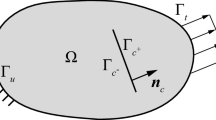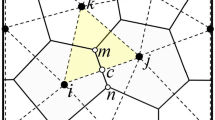Abstract
Under extreme loading conditions most often the extent of material and structural fracture is pervasive in the sense that a multitude of cracks are nucleating, propagating in arbitrary directions, coalescing, and branching. Pervasive fracture is a highly nonlinear process involving complex material constitutive behavior, material softening, localization, surface generation, and ubiquitous contact. A pure Lagrangian computational method based on randomly close packed Voronoi tessellations is proposed as a rational and robust approach for simulating the pervasive fracture of materials and structures. Each Voronoi cell is formulated as a finite element using the Reproducing Kernel Method. Fracture surfaces are allowed to nucleate only at the intercell faces, and cohesive tractions are dynamically inserted. The randomly seeded Voronoi cells provide a regularized random network for representing fracture surfaces. Example problems are used to demonstrate the proposed numerical method. The primary numerical challenge for this class of problems is the demonstration of model objectivity and, in particular, the identification and demonstration of a measure of convergence for engineering quantities of interest.
Similar content being viewed by others
References
Aste R, Weaire D (2000) The pursuit of perfect packing. Institute of Physics Publishing, Bristol
Attaway S, Heinstein M, Swegle J (1994) Coupling of smooth particle hydrodynamics with the finite element method. Nuclear Eng Design 150: 199–205
Bazant Z (2005) Scaling of structural strength. Elsevier, Amsterdam
Bazant Z, Planas J (1997) Fracture and size effect in concrete and other quasibrittle materials. CRC Press, Boca Raton
Belytschko T, Black T (1999) Elastic crack growth in finite elements with minimal remeshing. Int J Numer Methods Eng 45: 601–620
Belytschko T, Krongauz Y, Organ D, Flemin M, Krysl P (1996) Meshless melthods: an overview and recent developments. Comput Methods Appl Mech Eng 139: 3–47
Belytschko T, Krysl P, Krongauz Y (1997) A three-dimensional explicit element-free Galerkin method. Int J Numer Methods Fluids 24: 1253–1270
Belytschko T, Liu WK, Moran B (2000) Nonlinear finite elements for continua and structures, Ch. 4.7. Wiley, London
Belytschko T, Liu WK, Moran B (2000) Nonlinear finite elements for continua and structures, Ch. 6.2. Wiley, London
Bolander J, Saito S (1998) Fracture analyses using spring networks with random geometry. Eng Fract Mech 61: 569–591
Bolander J, Sukumar N (2005) Irregular lattice model for quasistatic crack propagation. Phys Rev B 71, 094106-1:12
Bowyer A (1981) Computing dirichlet tessellations. Comput J 2: 162–166
Camacho G, Ortiz M (1996) Computational modeling of impact damage in brittle materials. Int J Solids Struct 33: 2899–2938
Carpinteri A, Chiaia B, Invernizzi S (1999) Three-Dimensional fractal analysis of concrete fracture at the meso-level. Theor Appl Fract Mech 31: 163–172
Carpinteri A, Pugno N (2005) Fractal fragmentation theory for size effects of Quasi-Brittle materials in compression. Mag Concr Res 57: 309–313
Chen J, Wu C, Yoon S, You Y (2001) A stabalized conforming nodal integration for Galerkin mesh-free methods. Int J Numer Methods Eng 50: 435–466
Cusatis G, Cedolin L (2007) Two-scale study of concrete fracturing behavior. Eng Fract Mech 74: 3–17
Dai K, Liu G, Nguyen T (2007) An n-sided polygonal smoothed finite element method (nSFEM) for solid mechanics. Finite Elem Anal Des 43: 847–860
di Bernardo M, Budd C, Champneys A, Kowalczyk P (2008) Piecewise-smooth dynamical systems: theory and applications. Springer, Berlin
Finney J (1970) Random packings and the structure of simple liquids. I. The geometry of random close packing. In: Proceedings of the royal society of London. Series A, Mathematical and Physical Sciences, vol 319, pp 479–493
Gallian J (1994) Contemporary abstract algebra, 3rd edn. D.C Heath and Company
Ghosh S, Moorthy S (2004) Three dimensional Voronoi cell finite element model for microstructures with ellipsoidal heterogeneities. Comput Mech 34: 510–531
Hamming R. (1950) Error detecting and error correcting codes. Bell Syst Tech J 26: 147–160
Heinstein M, Mello F, Attaway S, Laurson T (2000) Contact-impact modeling in explicit transient dynamics. Comput Methods Appl Mech Eng 187: 621–640
Hinton E, Rock T, Zienkiewicz O (1976) A note on mass lumping and related processes in the finite element method. Earthq Eng Struct Dyn 4: 245–249
Hornbogen E (1989) Fractals in microstructure of metals. Int Mater Rev 34: 277–296
Hu C, Ghosh S (2008) Locally enhanced Voronoi cell finite element model (LE-VCFEM) for simulating evolving fracture in ductile microstructures containing inclusions. Int J Numer Methods Eng 76: 1955–1992
Hughes T (1987) The finite element method: linear static and dynamic finite element analysis, Ch. 4.4. Prentice-Hall, Englewood Cliffs
Hughes T (1987) The finite element method: linear static and dynamic finite element analysis, Ch. 4.5. Prentice-Hall, Englewood Cliffs
Hughes T (1987) The finite element method: linear static and dynamic finite element analysis, Ch. 7.3.2. Prentice-Hall, Englewood Cliffs
Idelsohn S, Onate E, Calvo N, Pin F (2003) The meshless finite element method. Int J Numer Methods Eng 58: 893–912
Johnson G, Beissel S, Stryk R (2002) An improved generalized particle algorithm that includes boundaries and interfaces. Int J Numer Methods Eng 53: 875–904
Josuttis N (1999) The C++ standard library: a tutorial and reference. Addison-Wesley, Reading
Kreyszig E (1989) Introductory functional analysis with applications, Ch. 1. Wiley, London
Kythe P (1995) An introduction to boundary element methods. CRC Press, Boca Raton
Li S, Ghosh S (2006) Multiple cohesive crack growth in brittle materials by the extended Voronoi cell finite element model. Int J Fract 141: 373–393
Li S, Ghosh S (2006) Extended Voronoi cell finite element model for multiple cohesive crack propagation in brittle materials. Int J Numer Methods Eng 65: 1028–1067
Lindgren B (1976) Statistical theory, 3rd edn., Ch. 2.5. Macmillan Publishing Co., New York
Liu W, Jun S, Zhang Y (1995) Reproducing kernel particle methods. Int J Numer Methods Eng 20: 1081–1106
Lowen H (2000) Fun with hard spheres. In: Mecke K, Stoyan D (eds) Statistical physics and spatial statistics. The art of analyzing spatial structures and pattern formation. Springer lecture notes in physics, vol 554, pp 295–331
Mohammadi S (2003) Discontinuum mechanics: using discrete and finite elements. WIT Press, Billerica
Molinari J, Gazonas G, Raghupathy R, Rusinek A, Zhou F (2007) The cohesive element approach to dynamic fragmentation: the question of energy convergence. Int J Numer Methods Eng 69: 484–503
Okabe A, Boots B, Sugihara K, Chiu S (2000) Spatial tessellations: concepts and applications of Voronoi diagrams. Wiley, London
Ortiz M, Pandolfi A (1999) Finite-Deformation irreversible cohesive elements for three-dimensional crack-propagation analysis. Int J Numer Methods Eng 44: 1267–1282
Pandolfi A, Krysl P, Ortiz M (1999) Finite element simulation of ring expansion and fragmentation: the capturing of length and time scales through cohesive models of fracture. Int J Fract 95: 279–297
Pandolfi A, Ortiz M (2002) An efficient adaptive procedure for three-dimensional fragmentation simulations. Eng Comput 18: 148–159
Park Y, Fahrenthold E (2005) A Kernel free Particle-Finite element method for hypervelocity impact simulation. Int J Numer Methods Eng 63: 737–759
Perfect E (1997) Fractal models for the fragmentation of rocks and soils: a review. Eng Geol 48: 185–198
Planas J, Elices M, Guinea G, Gomez F, Cendon D, Arbilla I (2003) Generalizations and specializations of cohesive crack models. Eng Fract Mech 70: 1759–1776
Rabczuk T, Belytschko T (2004) Cracking particles: a simplified meshfree method for arbitrary evolving cracks. Int J Numer Methods Eng 61: 2316–2343
Rashid M, Selimotic M (2006) A three-dimensional finite element method with arbitrary polyhedral elements. Int J Numer Methods Eng 67: 226–252
Ruiz G, Ortiz M, Pandolfi A (2000) Three-Dimensional finite-element simulation of the dynamic brazilian test on concrete cylinders. Int J Numer Methods Eng 48: 963–994
Ruiz G, Pandolfi A, Ortiz M (2001) Three-Dimensional cohesive modeling of dynamic mixed-mode fracture. Int J Numer Methods Eng 52: 97–120
Schuster H, Just W (2005) Deterministic chaos, an introduction, 4th edn. Wiley-VCH, New York
Silling S, Askari E (2005) A meshfree method based on the peridynamic model of solid mechanics. Comput Struct 83: 1526–1535
Strogatz S (1994) Nonlinear dynamics and chaos with applications to physics, biology, chemistry, and engineering, Ch. 9. Westview Press, Boulder
Strouboulis T, Copps K, Babuska I (2000) The generalized finite element method: an example of its implementation and illustration of its performance. Int J Numer Methods Eng 47: 1401–1417
Sukumar N, Tabarraei A (2004) Conforming polygonal finite elements. Int J Numer Methods Eng 61: 2045–2066
Sulsky D, Schreyer L (2004) MPM simulation of dynamic material failure with a decohesion constitutive model. Eur J Mech A/Solids 23: 423–445
Wachspress E (1975) A rational finite element basis. Academic Press, London
Watson D (1981) Computing the n-Dimensional tessellation with application to Voronoi polytopes. Comput J 2: 167–172
Yip M, Li Z, Liao B, Bolander J (2006) Irregular lattice models of fracture of multiphase particulate materials. Int J Fract 140: 113–124
Yip M, Mohle J, Bolander J (2005) Automated modeling of three-dimensional structural components using irregular lattices. Comput Aided Civil Infrastructure Eng 20: 393–407
Zallen R (2004) The physics of amorphous solids, Ch. 2. Wiley-VCH, New York
Author information
Authors and Affiliations
Corresponding author
Additional information
Sandia is a multi-program laboratory operated by Sandia Corporation, a Lockheed Martin Company, for the United States Department of Energy’s National Nuclear Security Administration under Contract DE-AC04-94AL85000.
Rights and permissions
About this article
Cite this article
Bishop, J.E. Simulating the pervasive fracture of materials and structures using randomly close packed Voronoi tessellations. Comput Mech 44, 455–471 (2009). https://doi.org/10.1007/s00466-009-0383-6
Received:
Accepted:
Published:
Issue Date:
DOI: https://doi.org/10.1007/s00466-009-0383-6




